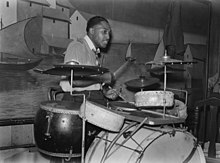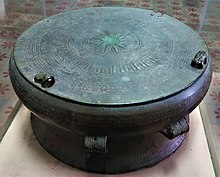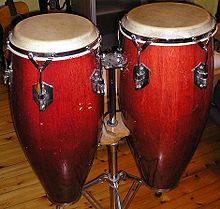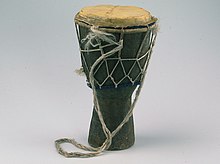Drum & Bass - the Eden Project - Again





The drum is a member of the percussion group of musical instruments. In the Hornbostel-Sachs classification organisation, it is a membranophone.[1] Drums consist of at least one membrane, called a drumhead or drum skin, that is stretched over a beat and struck, either directly with the player's hands, or with a percussion mallet, to produce audio. There is usually a resonant caput on the underside of the drum. Other techniques have been used to cause drums to brand sound, such equally the pollex roll. Drums are the globe's oldest and most ubiquitous musical instruments, and the basic design has remained virtually unchanged for thousands of years.[i]
Drums may be played individually, with the histrion using a unmarried drum, and some drums such as the djembe are nigh always played in this way. Others are ordinarily played in a set of two or more than, all played by the one player, such as bongo drums and timpani. A number of different drums together with cymbals form the bones modern drum kit.
Uses [edit]
Drums are ordinarily played past hitting with the mitt, a beater attached to a pedal, or with one or ii sticks with or without padding. A broad variety of sticks are used, including wooden sticks and sticks with soft beaters of felt on the stop. In jazz, some drummers use brushes for a smoother, quieter audio. In many traditional cultures, drums accept a symbolic function and are used in religious ceremonies. Drums are often used in music therapy, especially manus drums, because of their tactile nature and piece of cake employ by a broad multifariousness of people.[two]
In popular music and jazz, "drums" usually refers to a drum kit or a set of drums (with some cymbals, or in the case of harder rock music genres, many cymbals), and "drummer" to the person who plays them.
Drums acquired even divine condition in places such every bit Burundi, where the karyenda was a symbol of the power of the rex.
Construction [edit]
The beat virtually always has a circular opening over which the drumhead is stretched, only the shape of the remainder of the beat out varies widely. In the Western musical tradition, the almost usual shape is a cylinder, although timpani, for instance, use bowl-shaped shells.[1] Other shapes include a frame design (tar, Bodhrán), truncated cones (bongo drums, Ashiko), goblet shaped (djembe), and joined truncated cones (talking drum).
Drums with cylindrical shells can be open at 1 stop (as is the case with timbales), or can have two drum heads, one caput on each finish. Single-headed drums typically consist of a skin stretched over an enclosed infinite, or over one of the ends of a hollow vessel. Drums with ii heads covering both ends of a cylindrical shell often accept a small pigsty somewhat halfway betwixt the ii heads; the shell forms a resonating chamber for the resulting sound. Exceptions include the African slit drum, also known as a log drum every bit it is made from a hollowed-out tree torso, and the Caribbean area steel drum, made from a metal barrel. Drums with two heads can also have a set up of wires, called snares, held across the bottom caput, top caput, or both heads, hence the name snare drum.[one] On some drums with two heads, a pigsty or bass reflex port may be cut or installed onto one head, as with some 2010s era bass drums in stone music.
On modern band and orchestral drums, the drumhead is placed over the opening of the drum, which in turn is held onto the shell by a "counterhoop" (or "rim"), which is then held past means of a number of tuning screws chosen "tension rods" that screw into lugs placed evenly around the circumference. The head'south tension can be adjusted by loosening or tightening the rods. Many such drums take six to 10 tension rods. The audio of a drum depends on many variables—including shape, shell size and thickness, beat materials, counterhoop material, drumhead fabric, drumhead tension, drum position, location, and striking velocity and angle.[1]
Prior to the invention of tension rods, drum skins were fastened and tuned by rope systems—every bit on the Djembe—or pegs and ropes such as on Ewe drums. These methods are rarely used today, though sometimes appear on regimental marching band snare drums.[one] The head of a talking pulsate, for example, tin be temporarily tightened past squeezing the ropes that connect the peak and bottom heads. Similarly, the tabla is tuned by hammering a disc held in place effectually the pulsate by ropes stretching from the top to bottom head. Orchestral timpani can be quickly tuned to precise pitches by using a foot pedal.
Audio [edit]

Several factors make up one's mind the sound a drum produces, including the type, shape and construction of the pulsate crush, the type of drum heads it has, and the tension of these drumheads. Dissimilar drum sounds accept different uses in music. For example, the modern Tom-tom drum. A jazz drummer may want drums that are loftier pitched, resonant and quiet whereas a rock drummer may adopt drums that are loud, dry and low-pitched.
The pulsate head has the most result on how a drum sounds. Each type of drum head serves its ain musical purpose and has its own unique sound. Double-ply drumheads dampen high frequency harmonics because they are heavier and they are suited to heavy playing.[three] Pulsate heads with a white, textured coating on them muffle the overtones of the drum head slightly, producing a less diverse pitch. Pulsate heads with central silvery or black dots tend to muffle the overtones fifty-fifty more, while drum heads with perimeter sound rings by and large eliminate overtones. Some jazz drummers avoid using thick drum heads, preferring single ply drum heads or pulsate heads with no muffling. Rock drummers often prefer the thicker or coated drum heads.
The second biggest factor that affects drum sound is caput tension against the shell. When the hoop is placed effectually the pulsate head and crush and tightened downwards with tension rods, the tension of the head tin be adjusted. When the tension is increased, the amplitude of the sound is reduced and the frequency is increased, making the pitch higher and the volume lower.
The type of beat too affects the sound of a drum. Because the vibrations resonate in the shell of the drum, the shell tin exist used to increment the book and to dispense the type of sound produced. The larger the diameter of the vanquish, the lower the pitch. The larger the depth of the drum, the louder the volume. Shell thickness also determines the volume of drums. Thicker shells produce louder drums. Mahogany raises the frequency of low pitches and keeps college frequencies at well-nigh the aforementioned speed. When choosing a ready of shells, a jazz drummer may want smaller maple shells, while a stone drummer may desire larger birch shells.
History [edit]

Drums made with alligator skins have been found in Neolithic cultures located in China, dating to a period of 5500–2350 BC. In literary records, drums manifested shamanistic characteristics and were often used in ritual ceremonies.[4]
The bronze Dong Son pulsate was fabricated past the Bronze Age Dong Son culture of northern Vietnam. They include the ornate Ngoc Lu drum.
Beast drumming [edit]
Macaque monkeys pulsate objects in a rhythmic way to show social dominance and this has been shown to exist candy in a similar way in their brains to vocalizations, suggesting an evolutionary origin to drumming as function of social communication.[five] Other primates brand drumming sounds past chest chirapsia or hand clapping,[6] [seven] and rodents such as kangaroo rats also make similar sounds using their paws on the footing.[8]
Talking drums [edit]
Drums are used non only for their musical qualities, just too as a means of communication over neat distances. The talking drums of Africa are used to imitate the tone patterns of spoken language. Throughout Sri Lankan history drums have been used for advice betwixt the country and the community, and Sri Lankan drums have a history stretching back over 2500 years.
Drums in fine art [edit]

Drumming may be a purposeful expression of emotion for entertainment, spiritualism and communication. Many cultures practice drumming every bit a spiritual or religious passage and interpret drummed rhythm similarly to spoken language or prayer. Drumming has adult over millennia to be a powerful art form. Drumming is commonly viewed as the root of music and is sometimes performed equally a kinesthetic trip the light fantastic. As a discipline, drumming concentrates on grooming the body to punctuate, convey and interpret musical rhythmic intention to an audience and to the performer.
Military uses [edit]
Chinese troops used tàigǔ drums to motivate troops, to help set a marching pace, and to phone call out orders or announcements. For example, during a state of war betwixt Qi and Lu in 684 BC, the outcome of pulsate on soldiers' morale is employed to change the consequence of a major boxing. Fife-and-drum corps of Swiss mercenary foot soldiers also used drums. They used an early version of the snare drum carried over the player's right shoulder, suspended by a strap (typically played with one hand using traditional grip). It is to this instrument that the English language word "drum" was offset used. Similarly, during the English Civil War rope-tension drums would exist carried by junior officers as a ways to relay commands from senior officers over the noise of boxing. These were as well hung over the shoulder of the drummer and typically played with two pulsate sticks. Different regiments and companies would have distinctive and unique drum beats but they recognized. In the mid-19th century, the Scottish military started incorporating pipe bands into their Highland regiments.[9]
During pre-Columbian warfare, Aztec nations were known to have used drums to ship signals to the battling warriors. The Nahuatl word for drum is roughly translated as huehuetl.[x]
The Rig Veda, one of the oldest religious scriptures in the world, contains several references to the use of the Dundhubi (war drum). Arya tribes charged into battle to the beating of the state of war drum and chanting of a hymn that appears in Book VI of the Rig Veda and likewise the Atharva Veda where it is referred to equally the "Hymn to the battle drum".
Types [edit]

Handscroll item of a Chinese percussionist playing a drum for a dancing woman, from a 12th-century remake of Gu Hongzhong's 10th-century originals, Song dynasty.
- Aburukuwa
- Ashiko
- Atumpan
- Bara
- Bass drum
- Batá
- Bedug
- Bodhrán
- Bongo drums
- Bougarabou
- Cajón
- Candombe drums
- Chalice drum
- Chenda
- Cocktail pulsate
- Conga
- Crowdy-crawn
- Darbuka
- Damphu
- Davul
- Dayereh
- Dhak
- Dhimay
- Dhol
- Dholak
- Djembe
- Dong Son drum
- Doumbek
- Dunun
- Ewe drums
- Fontomfrom
- Frame drum
- Goblet drum
- Hand drum
- Idakka
- Ilimba drum
- Karyenda
- Kendang
- Kpanlogo
- Lambeg drum
- Log drum
- Madal
- Mridangam
- Pahu
- Pakhavaj
- Repinique
- Side drum (marching snare pulsate)
- Slit drum
- Snare pulsate
- Surdo
- Tabor
- Tamborim
- Tambourine
- Taiko
- Tabla
- Talking drum
- Tassa (Tasha drum)
- Tapan
- Tar
- Tavil
- Tenor drum
- Timbales
- Timpani
- Tombak
- Tom-tom pulsate
- Tongue pulsate
- Zabumba
See besides [edit]
- Blast beat
- Double drumming
- Drum trounce
- Pulsate circle
- Drumline
- Pulsate motorcar
- Drum replacement
- Drumsticks
- Electronic pulsate
- Gallop
- Hearing the shape of a pulsate
- Listing of drummers
- Practice pad
- Vibrations of a circular pulsate
References [edit]
- ^ a b c d east f Grove, George (Jan 2001). Stanley Sadie (ed.). The New Grove Encyclopædia of Music and Musicians (2nd ed.). Grove's Dictionaries of Music. pp. Volume 5, pp638–649. ISBN978-1-56159-239-5.
- ^ Weiss, Rick (July 5, 1994). "Music Therapy". The Washington Post. No. Jul 5, 1994.
- ^ Drum Lessons - Drumbook.org
- ^ Liu, Li (2007). The Chinese Neolithic: Trajectories to Early on States. Cambridge: Cambridge University Press. ISBN 0-521-01064-0, p. 123
- ^ Remedios, R; Logothetis, NK; Kayser, C (2009). "Monkey drumming reveals common networks for perceiving vocal and nonvocal communication sounds". Proceedings of the National Academy of Sciences of the United States of America. 106 (42): 18010–5. Bibcode:2009PNAS..10618010R. doi:10.1073/pnas.0909756106. PMC2755465. PMID 19805199.
- ^ Clark Arcadi, A; Robert, D; Mugurusi, F (2004). "A comparison of buttress drumming by male chimpanzees from two populations". Primates; Journal of Primatology. 45 (2): 135–ix. doi:10.1007/s10329-003-0070-8. PMID 14735390. S2CID 8141024.
- ^ Kalan, AK; Rainey, HJ. (2009). "Hand-clapping every bit a communicative gesture past wild female swamp gorillas". Primates. 50 (three): 273–5. doi:10.1007/s10329-009-0130-ix. PMID 19221858. S2CID 24427744.
- ^ Randall, JA. (2001). "Evolution and Role of Drumming every bit Communication in Mammals". American Zoologist. 41 (5): 1143–1156. CiteSeerX10.one.1.577.2992. doi:10.1668/0003-1569(2001)041[1143:EAFODA]2.0.CO;2.
- ^ Chatto, Allan. (1996). Brief History of Drumming. Archived March 15, 2010, at the Wayback Car
- ^ Aguilar-Moreno, Manuel. (2006). [Handbook to Life In the Aztec World]
External links [edit]
| | Wikimedia Commons has media related to Drums. |
| | Wikiquote has quotations related to: Drum |
-
 The dictionary definition of drum at Wiktionary
The dictionary definition of drum at Wiktionary - . Encyclopædia Britannica. Vol. 8 (11th ed.). 1911.
- Drums (Polish folk musical instruments)
- Pulsate resources at Curlie
Source: https://en.wikipedia.org/wiki/Drum
0 Response to "Drum & Bass - the Eden Project - Again"
แสดงความคิดเห็น